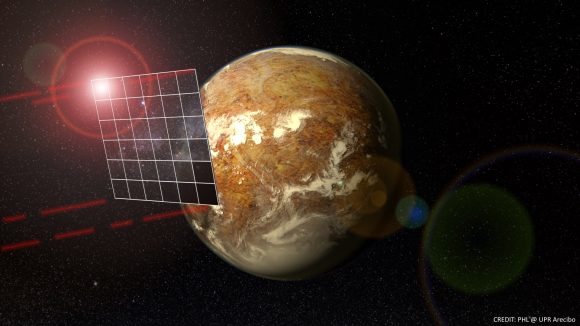The number of confirmed extra-solar planets has increased by leaps and bounds in recent years. With every new discovery, the question of when we might be able to explore these planets directly naturally arises. There have been several suggestions so far, ranging from laser-sail driven nanocraft that would travel to Alpha Centauri in just 20 years (Breakthrough Starshot) to slower-moving microcraft equipped with a gene laboratories (The Genesis Project).
But when it comes to braking these craft so that they can slow down and study distant stars and orbit planets, things become a bit more complicated. According to a recent study by the very man who conceived of The Genesis Project – Professor Claudius Gros of the Institute for Theoretical Physics Goethe University Frankfurt – special sails that rely on superconductors to generate magnetic fields could be used for just this purpose.
Starshot and Genesis are similar in that both concepts seek to leverage recent advancements in miniaturization. Today, engineers are able to create sensors, thrusters and cameras that are capable of carrying out computations and other functions, but are a fraction of the size of older instruments. And when it comes to propulsion, there are many options, ranging from conventional rockets and ion drives to laser-driven light sails.

Slowing an interstellar mission down, however, has remained a more significant challenge because such a craft cannot be fitted with braking thrusters and fuel without increasing its weight. To address this, Professor Gros suggests using magnetic sails, which would present numerous advantages over other available methods. As Prof. Gros explained to Universe Today via email:
“Classically, you would equip the spacecraft with rocket engines. Normal rocket engines, as we are using them for launching satellites, can change the velocity only by 5-15 km/s. And even that only when using several stages. That is not enough to slow down a craft flying at 1000 km/s (0.3% c) or 100000 km/s (c/3). Fusion or antimatter drives would help a bit, but not substantially.”
The sail he envisions would consist of a massive superconducting loop that measures about 50 kilometers in diameter, which would create a magnetic field once a lossless current was induced. Once activated, the ionized hydrogen in the interstellar medium would be reflected off the sail’s magnetic field. This would have the effect of transferring the spacecraft’s momentum to the interstellar gas, gradually slowing it down.
According to Gros’ calculations, this would work for slow-travelling sails despite the extremely low particle density of interstellar space, which works out to 0.005 to 0.1 particles per cubic centimeter. “A magnetic sail trades energy consumption with time,” said Gros.”If you turn off the engine of your car and let it roll idle, it will slow down due to friction (air, tires). The magnetic sail does the same, where the friction comes from the interstellar gas.”

One of the advantages of this method is the fact that can be built using existing technology. The key technology behind the magnetic sail is a Biot Savart loop which, when paired with the same kind of superconducting coils used in high-energy physics, would create a powerful magnetic field. Using such a sail, even heavier spacecraft – those that weight up to 1,500 kilograms (1.5 metric tonnes; 3,307 lbs) – could be decelerated from an interstellar voyage.
The one big drawback is the time such a mission would take. Based on Gros’ own calculations, a high speed transit to Proxima Centauri that relied on magnetic momentum braking would require a ship that weighed about 1 million kg (1000 metric tonnes; 1102 tons). However, an interstellar mission involving a 1.5 metric tonne ship would be able to reach TRAPPIST-1 in about 12,000 years. As Gros concludes:
“It takes a long time (because the very low density of the interstellar media). That is bad if you want to see a return (scientific data, exciting pictures) in your lifetime. Magnetic sails work, but only when you are happy to take the (very) long perspective.”
In other words, such a system would not work for a nanocraft like that envisioned by Breakthrough Starshot. As Starshot’s own Dr. Abraham Loeb explained, the main goal of the project is to achieve the dream of interstellar travel within a generation of the ship’s departure. In addition to being the Frank B. Baird Jr. Professor of Science at Harvard University, Dr. Loeb is also the Chair of the Breakthrough Starshot Advisory Committee.

As he explained to Universe Today via email:
“[Gros] concludes that breaking on the interstellar gas is feasible only at low speeds (less than a fraction of a percent of the speed of light) and even then one needs a sail that is tens of miles wide, weighting tons. The problem is that with such a low speed, the journey to the nearest stars will take over a thousand years.
“The Breakthrough Starshot initiative aims to launch a spacecraft at a fifth of the speed of light so that it will reach the nearest stars within a human lifetime. It is difficult to get people excited about a journey whose completion will not be witnessed by them. But there is a caveat. If the longevity of people could be extended to millennia by genetic engineering, then designs of the type considered by Gros would certainly be more appealing.”
But for missions like The Genesis Project, which Gros originally proposed in 2016, time is not a factor. Such a probe, which would carry single-celled organisms – either encoded in a gene factory or stored as cryogenically-frozen spores – a could take thousands of years to reach a neighboring star system. Once there, it would begin seeding planets that had been identified as “transiently habitable” with single-celled organisms.
For such a mission, travel time is not the all-important factor. What matters is the ability to slow down and establish orbit around a planet. That way, the spacecraft would be able to seed these nearby worlds with terrestrial organisms, which could have the effect of slowly terraforming it in advance of human explorers or settlers.
Given how long it would take for humans to reach even the nearest extra-solar planets, a mission that last a few hundred or a few thousand years is no big deal. In the end, which method we choose to conduct interstellar mission will come down to how much time we’re willing to invest. For the sake of exploration, expedience is the key factor, which means lightweight craft and incredibly high speeds.
But where long-term goals – such as seeding other worlds with life and even terraforming them for human settlement – are concerned, the slow and steady approach is best. One thing is for sure: when these types of missions move from the concept stage to realization, it sure will be exciting to witness!
Further Reading: Goete University Frankfurt, Journal of Physics Communications

